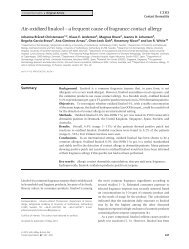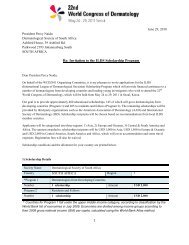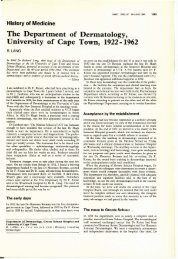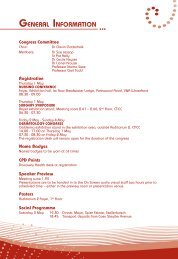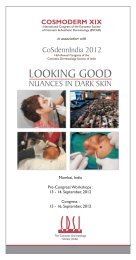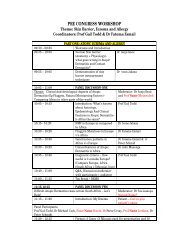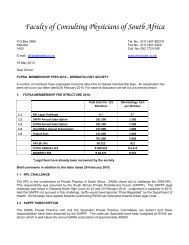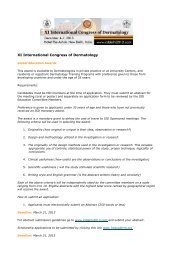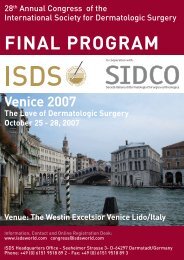Guidelines on the Management of Atopic Dermatitis ... - Dermatology
Guidelines on the Management of Atopic Dermatitis ... - Dermatology
Guidelines on the Management of Atopic Dermatitis ... - Dermatology
You also want an ePaper? Increase the reach of your titles
YUMPU automatically turns print PDFs into web optimized ePapers that Google loves.
The amount <strong>of</strong> TCS to use is a comm<strong>on</strong> practical problem for patients. The fingertip unit is<br />
useful: Index finger from distal crease to fingertip equals 0.5g. This aids m<strong>on</strong>itoring<br />
compliance and use. There is no clear evidence to suggest that twice-daily applicati<strong>on</strong> <strong>of</strong><br />
TCS is better than a <strong>on</strong>ce-daily applicati<strong>on</strong>. It would be justifiable to use <strong>on</strong>ce-daily<br />
corticosteroids as a first step in all patients with atopic dermatitis, thus reducing cost,<br />
improving compliance and reducing side-effects.<br />
No c<strong>on</strong>vincing evidence is available to dem<strong>on</strong>strate superior clinical efficacy <strong>of</strong><br />
corticosteroid-antibiotic combinati<strong>on</strong> products to corticosteroids al<strong>on</strong>e. When efficacy <strong>of</strong> TCS<br />
is reduced, this is thought to be related to disease severity ra<strong>the</strong>r than corticosteroid<br />
resistance. 14<br />
There are many challenges <strong>on</strong> <strong>the</strong> subject <strong>of</strong> TCS use, especially in <strong>the</strong> light <strong>of</strong> steroid<br />
abuse, steroid misuse, steroid phobia and side-effects. Adverse effects are well documented<br />
and it is important to recognise <strong>the</strong> side-effects <strong>of</strong> skin atrophy, telangiectasia,<br />
hypopigmentati<strong>on</strong>, steroid acne, hirsutism, rosacea and c<strong>on</strong>tact sensitisati<strong>on</strong> to <strong>the</strong> steroid<br />
itself. Skin thinning is not a problem when topical steroids are used correctly.<br />
Uncomm<strong>on</strong> systemic effects are <strong>the</strong> suppressi<strong>on</strong> <strong>of</strong> <strong>the</strong> hypothalamic-pituitary-adrenal axis,<br />
growth retardati<strong>on</strong>, tachyphylaxis, glaucoma, cataract formati<strong>on</strong> and Cushing‟s syndrome. 15<br />
Over recent years <strong>the</strong> risk <strong>of</strong> adverse effects <strong>of</strong> TCS has been reduced by optimising<br />
applicati<strong>on</strong> protocols and using newer steroid preparati<strong>on</strong>s with improved risk/benefit ratios,<br />
e.g. prednicarbate, mometas<strong>on</strong>e furoate, fluticas<strong>on</strong>e and methylprednisol<strong>on</strong>e acep<strong>on</strong>ate. 9,10<br />
This improved risk/benefit ratio means that <strong>the</strong> products may be used at a younger age (from<br />
<strong>the</strong> age <strong>of</strong> four m<strong>on</strong>ths) and for l<strong>on</strong>ger periods (for four weeks c<strong>on</strong>tinuously in babies and<br />
three m<strong>on</strong>ths in older children and adults). 16 Should <strong>the</strong>se drugs be required at a younger<br />
age and for l<strong>on</strong>ger periods, as is <strong>of</strong>ten <strong>the</strong> case, <strong>the</strong> benefit versus risk should be evaluated<br />
in each individual case and <strong>the</strong> appropriate formulati<strong>on</strong> carefully selected. Intermittent dosing<br />
should be used as far as possible.<br />
The judicious use <strong>of</strong> TCS would include short-term appropriate applicati<strong>on</strong>s as initial<br />
m<strong>on</strong>o<strong>the</strong>rapy or in combinati<strong>on</strong> with o<strong>the</strong>r <strong>the</strong>rapeutic agents that ideally possess<br />
complementing mechanisms <strong>of</strong> acti<strong>on</strong>. These drugs could be ei<strong>the</strong>r systemic agents or<br />
topical agents such as <strong>the</strong> topical calcineurin inhibitors. 17<br />
Topical calcineurin inhibitors (TCIs) [1++; A]<br />
TCIs (pimecrolimus and tacrolimus) are complex macrocyclic compounds that result in<br />
selective inhibiti<strong>on</strong> <strong>of</strong> cytokine transcripti<strong>on</strong> in activated T-cells. Pimecrolimus selectively<br />
targets T cells and mast cells. In c<strong>on</strong>trast to tacrolimus, pimecrolimus has no effects <strong>on</strong> <strong>the</strong><br />
differentiati<strong>on</strong>, maturati<strong>on</strong> and functi<strong>on</strong> <strong>of</strong> dendritic cells. In c<strong>on</strong>trast to corticosteroids, TCIs<br />
do not affect endo<strong>the</strong>lial cells and fibroblasts and thus do not induce skin atrophy.<br />
TCIs are registered for short-term and n<strong>on</strong>-c<strong>on</strong>tinuous chr<strong>on</strong>ic treatment <strong>of</strong> moderate to<br />
severe atopic dermatitis in immunocompetent patients aged two years or older. 18,19 Clinical<br />
trial data have proven that pimecrolimus 20,21 and tacrolimus 22 reduces <strong>the</strong> incidence <strong>of</strong> flares<br />
and has a significant effect <strong>on</strong> reducing pruritus.<br />
Pimecrolimus and tacrolimus are safe and effective in reducing <strong>the</strong> severity <strong>of</strong> atopic<br />
dermatitis symptoms in children and adults. In South Africa, pimecrolimus 10mg/1gm and<br />
tacrolimus 0.03% are registered for use from two years <strong>of</strong> age. Tacrolimus 0.1% is<br />
registered for use in patients older than 15 years.




